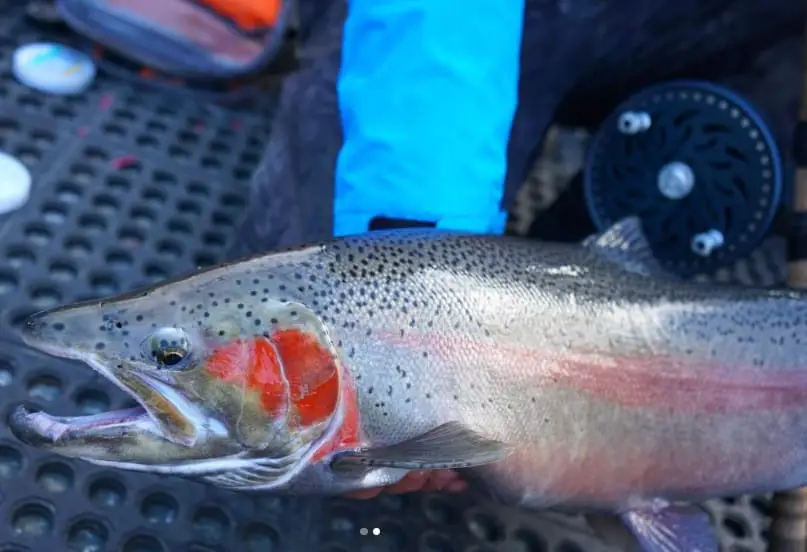Guide Tactics For Spring Steelhead Fishing In Michigan
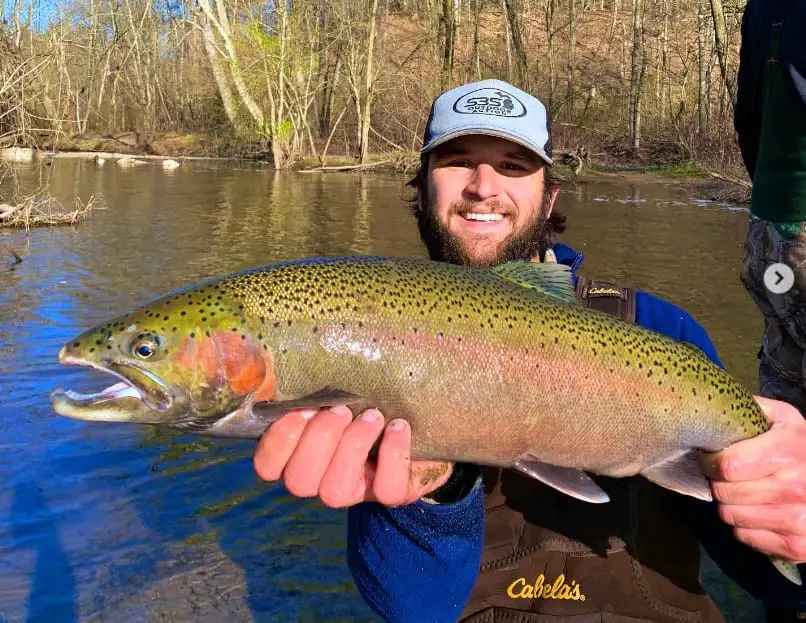
Spring steelhead fishing in Michigan can be fantastic with lots of good opportunities on just about all the rivers flowing into the three Great Lakes that surround the state of Michigan.
Spring is spawning time and is when the most steelhead are in the river which is why many anglers consider this to be the best steelhead fishing of the year.
- Starts: Spring steelhead fishing starts as the ice starts to break up on the rivers. This usually occurs in early March.
- Ends: Steelhead fishing is usually finished in most rivers by the middle of May.
- Peak Time: Peak fishing is from late March to Early May. Often after the water settles and clears after big rains.
- Methods: All methods work. Float fishing, fly fishing, and casting lures are best.
- Baits: Best baits include spawn sacs, beads, pink plastic worms or real worms, and artificial flies.
- Prime Locations: Look for spots below spawning beds, pool, and riffle areas with depths of 3 to 6 feet.
- Best Rivers: The rivers will open and start fishing best at different times, which I discuss below.
I will share the most effective spring steelhead fishing tactics that I use on guide trips, and I’ll discuss the three stages of spring steelhead fishing. If you are not fishing effectively, you are missing fish.
The Steelhead Runs
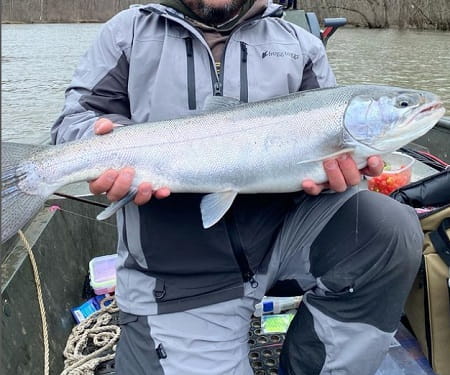
Spring steelhead fishing in Michigan is unique in that there are two primary runs to consider. The first runs consist of summer, fall, and winter steelhead that will hold in the river throughout the winter and not spawn until the spring.
These fish will be bigger and darker colored fish.
The second run of steelhead will start their spawning runs in late winter and early spring (February, March, and April).
These fresh-run spring steelhead can be bright silver or lightly colored.
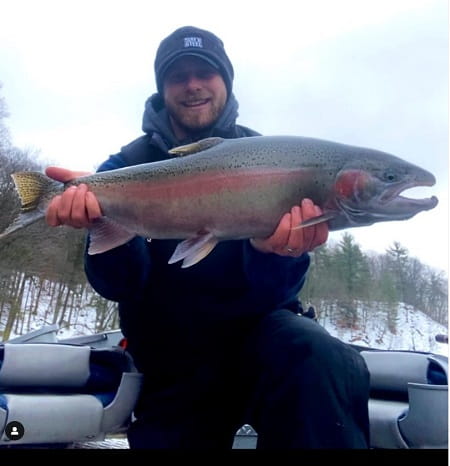
Many rivers will freeze solid over the winter months, so the spring steelhead fishing in Michigan usually starts in early March which is when the ice usually starts to break up and is when water temperatures start to warm up, and is when snowmelt and rains raise water levels.
This is often when I will still use winter steelhead fishing methods.
Rivers To Fish
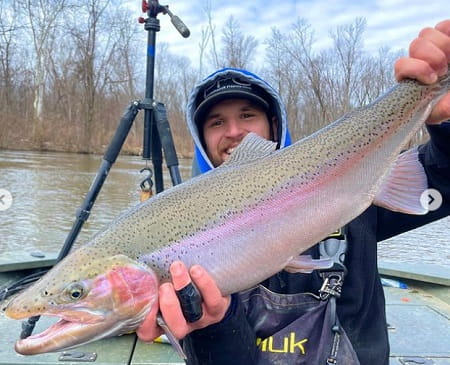
Water temperature best determines where to kick off the spring fishing in Michigan as it affects the migration of the steelhead.
Smaller rivers like the Pere Marquette River in Baldwin, the Rogue River in Rockford, and the White River in Hesperia tend to warm faster and can be good early-season hot spots.
Sunny days in February will activate fish, and cause snow melt which increases currents, so sunny days and late morning and mid-day fishing can be best.
Southern rivers like the Grand River around Grand Rapids, the Kalamazoo River, and the St Joseph River near South Bend will also become ice-free and provide excellent fishing before the rivers in Michigan’s upper peninsula start fishing well.
Western Michigan has some bigger rivers, and these larger rivers, like the Big Manistee River and the Muskegon River, can be ice-free all winter or early than other rivers.
East Coast Michigan rivers like the Au Sable River can also be excellent options in early spring.
Spring Steelhead Fishing Michigan: Stages of Steelhead Runs
I look at spring fishing as having three stages for steelhead. The average angler doesn’t consider this, but it can greatly affect how many fish they catch.
Stage 1: The Early Run
The steelhead that were holding in the river over the winter in deeper pools and the fresh run steelhead just coming in from the lake will start migrating to the best spawning areas around the same time.
This early run stage is an excellent time to catch steelheads because they are active and feeding as they move up the river. Anglers will find these fish just about everywhere in the river, from pocket water to deep pools, and these fish will fight hard.
Stage 2: The Spawning Stage
Steelheads seen in shallow waters with small gravel bottoms are usually spawning or ready to spawn. Unfortunately, spawning steelhead rarely eat, and if they have been spawning for days, they do not fight well.
These spawning fish should be left alone because fish on the spawning beds in the shallow water get spooked easily, and they don’t want to eat. The steelhead holding in the pools below are always much easier to catch, and they fight better.
Stage 3: The Drop Down and Drop Back Fish
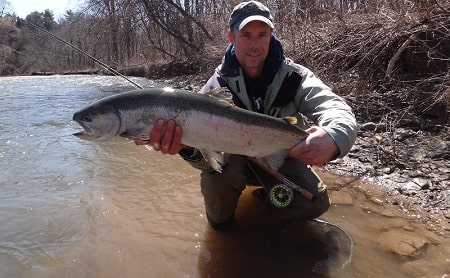
Stage three consists of what are called drop-down steelhead or drop-back steelhead.
Drop-down or drop-backs refers to the steelhead that have completed the spawn and are starting to drop-down the river or are dropping back to the lake.
Summer run steelhead will usually be the first to start dropping back and this could start in early March. The rest will drop back between late March and late May.
During this time, spawned-out steelhead are trying to recover and regain their strength, and they are often very hungry and aggressive. They can be so aggressive that my clients and I have caught the same steelhead twice in two casts.
These spring dropback steelheads can be found anywhere in the river, including shallow runs and pocket water, pools, and many will hold above or below dams like the Tippy Dam on the Manistee River or the Croton Dam on the Muskegon River.
However, one of the best places to fish for drop-downs are the first one or two deeper pools below known spawning beds.
Fishing Methods For Spring Steelhead
The following are the most effective fishing methods for steelhead.
Fly Fishing Method
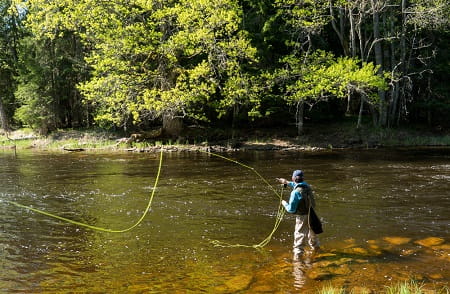
The fly-fishing method involves the use of artificial flies as bait.
This method is popular for fishing steelhead in shallow and smaller sections of the river.
Examples are as follows:
- Spey casting: This method uses heavy sink tips, bigger flies, and a double-handed fly rod, also known as the Spey rod. Spey fishing in mostly used on mid-sized to large rivers. Check out Spey Fishing For Steelhead.
- Streamer fishing uses a submerged fly that imitates a swimming baitfish, also known as a streamer. Steelhead are likely to feed on small fish that streamers imitate. Check out Streamer Fishing For Steelhead.
- Nymph Fishing: This method uses artificial flies that mimic aquatic insects like larvae, worms, eggs, and crustaceans. This fly-fishing method is very effective on steelhead and is often the most popular and most effective method. Check out Nymphing For Steelhead.
- Euro Nymphing: This method uses a sighter instead of an indicator combined with heavier weighted flies and lighter tippets. Euro Nymphing for steelhead is still relatively unknown, yet in some types of water, it is the most effective steelhead fly fishing technique. Check out Euro Nymphing For Steelhead.
For more in-depth information on fly fishing for steelhead, check out Fly Fishing For Steelhead: A Complete Guide.
Float Fishing Method

Float fishing is one of the most popular techniques.
It requires a float, also known as a bobber, and a leader line with split shots.
Float fishing is not suitable for all parts of the river. This method is most effective only in bigger and deeper pools and less effective in shallow water under 3 feet deep or in pocket water. For shallow water, you are better off using a method known as Bottom Bouncing.
Lure Fishing Method
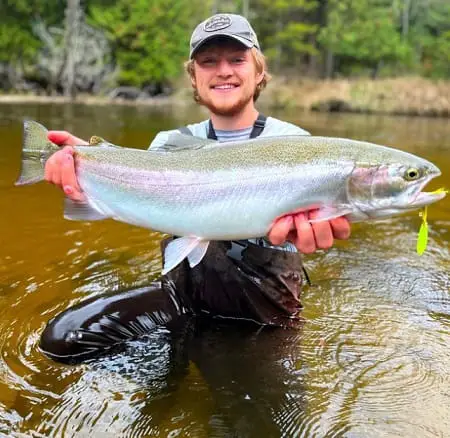
Lure fishing is prevalent and is used in all river sizes, depths, and flows.
This fishing method uses artificial baits known as a lures, which imitate baitfish.
Examples of effective and commonly used lures for steelhead fishing are:
- Jigs: are suitable for deep-water fishing as they use weighted hooks. For more check out Jig Fishing For Steelhead.
- Crankbaits: Minnow-type crankbaits like Rapalas are good options for steelhead.
- Spinners: Uses a flashy spinner blade at the top with a hook at the bottom.
- Spoons: are shaped like a concave spearhead, allowing them to wobble and to reflect light when moving and attract steelhead.
- Plugs: Plugs or wobblers like the Kwikfish or Flatfish are good options for steelhead fishing.
For more in-depth info on how to fish lures effectively, my best lures, proper sizes and colors, see Lure Fishing For Steelhead.
Three Other Methods
There are three other methods used by anglers and guides:
- Plunking: Plunking is a still-water, or stationary method. You will se guys use this at the river mouth, of piers, and beaches along the shores of the lake.
- Bobber Doggin: A relatively new method using a bobber, and in my recent article, I give you my honest opinion on this method.
- Drift Fishing: A good method using a semi-tight line, no bobber, and it works well on large rivers, fast currents, and deep water.
Baits For Michigan Spring Steelhead Fishing
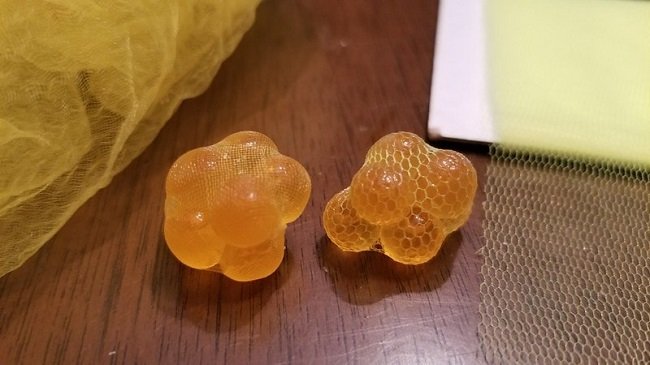
At times the steelhead will eat just about anything that drifts down the river past them. But these baits below are often the most effective.
However, don’t be one of those guys that only uses one bait all day and everyday.
For more on baits, check out 11 Best Baits For Steelhead.
Try these baits:
- Spawn Sacs – Use either salmon eggs or trout eggs. Dime-size to quarter-size sacs in orange, chartreuse, pink, white, and yellow. See Fishing With Spawn: Guide Tips To Make Spawn More Effective.
- Beads – Trout beads are one of the hottest baits for spring steelhead, and are often better than real salmon eggs and spawn sacs. Try 6mm, 8mm, and 10mm beads in the colors on my page Fishing With Beads.
- Artificial Flies: Fish them while float fishing, drift fishing, fly fishing, and bottom bouncing. At times, flies can be my most productive type of bait. See Best Steelhead Flies.
- Worms: Pink and red worms are often my most effective bait especially later in the spring when worms are prevalent. See Fishing With Worms: Guide Tips and Tactics.
Fishing Licences and Fishing Rules
All anglers 17-year-old and above are required to carry this license. They are easily accessed and processed online. Several options are available depending on the duration of the fishing activity.
But, when it comes to licenses and fishing rules this article might be out of date, so DO NOT rely on us for that information. Instead, check out the Michigan DNR website.
Spring Fishing Charters
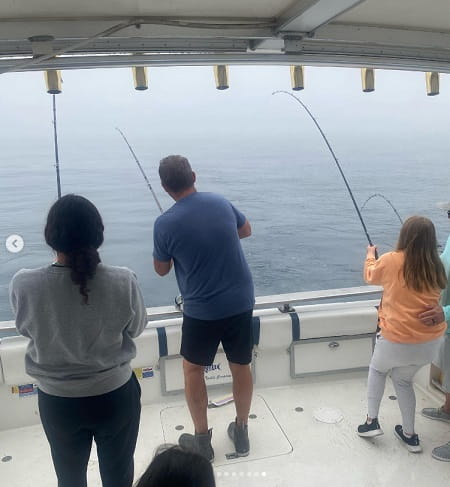
There are many charters and guides available for booking on Michigan’s most famous rivers and lakes.
Spring steelhead can be caught out in Lake Michigan, or on a Lake Michigan tributary. For lake fishing and river fishing guide trips check out Fire Plug Fishing Charters.
For river guide trips closer to Chicago, check out Get Bent Guide Service.
Lake Michigan Spring Steelhead
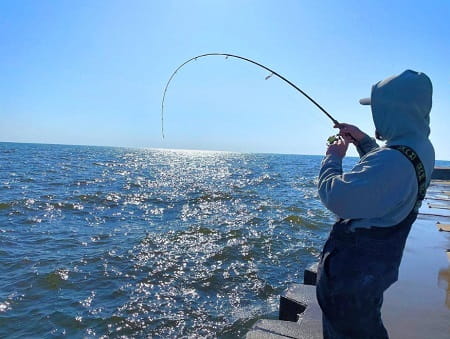
Some anglers prefer to fish Lake Michigan or Lake Huron from shore or from a boat.
Fishing out from the mouth of the Pere Marquette River, White River, and Big Manistee River are good.
Even large salmon and lake-run brown trout can be caught while fishing for steelhead. See Great Lakes Brown Trout Fishing.
Using streamers and lures off the piers can be effective with significant numbers of big migratory fish. Smallmouth bass are also possible here.
Check out these related articles.
Some Michigan rivers, like the St Joseph River, will also have a summer run steelhead known as a Skamania Steelhead that will also spawn in early spring, check out, Summer Steelhead Fishing In Michigan and Skamania Steelhead Fishing.
If you have a question or some advice on spring fishing in Michigan, let us know in the comments section below.
Tight Lines,
Graham

